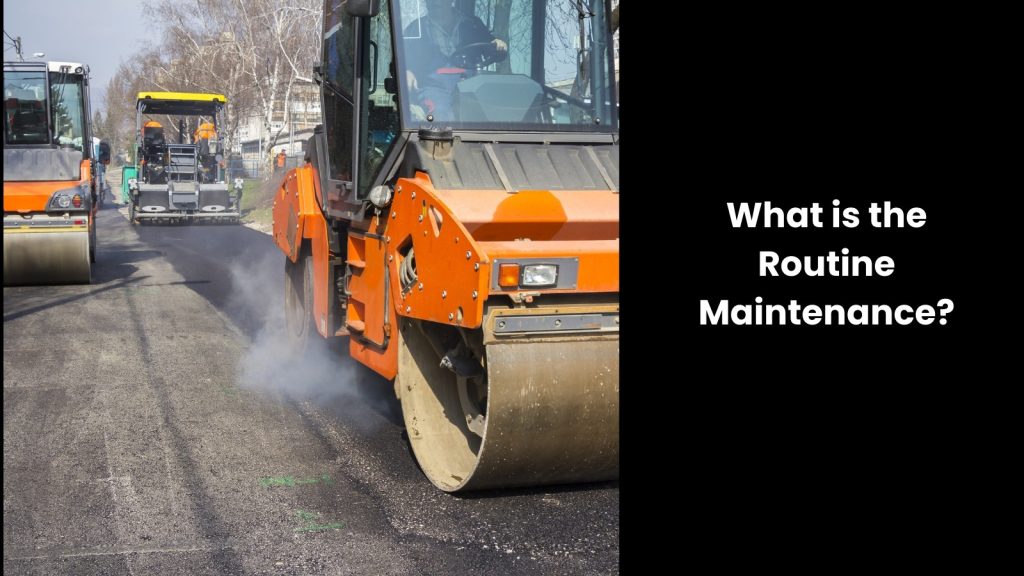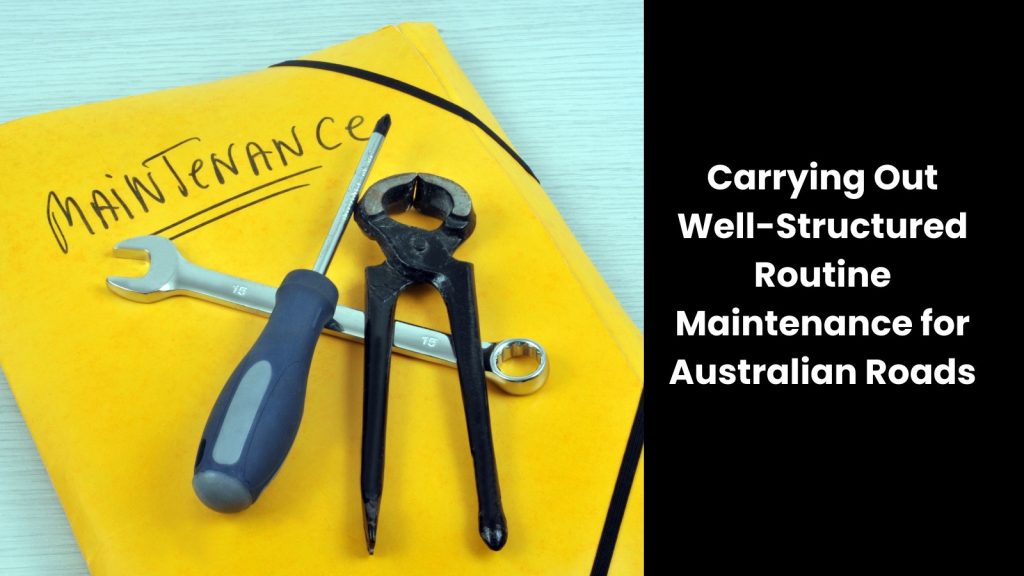Australia is enriched with a vast and diverse road network. This serves as the backbone of this Kangaroo nation’s freight and passenger transport. These roads play a critical role in facilitating economic activity, social connection, and access to essential services. But the problem lies in its maintenance, and it is certainly an ongoing challenge for the Australian authorities.
In this blog post, we discover the importance of routine maintenance for Australian roads, exploring its impact on safety, longevity, and overall network efficiency.
What is the Routine Maintenance?

- When it comes to road routine maintenance, this means regularly scheduled tasks to keep roads in good condition and ensure safety. This includes fixing potholes, clearing debris, maintaining signage, and inspecting road surfaces to prevent major damage. It ensures smooth, safe travel and prolongs the lifespan of the road infrastructure.
- Why is this necessary? Road routine maintenance is vital for keeping roads in good condition and ensuring safe travel. This involves a variety of tasks performed regularly to fix minor issues before they become major problems. Efficient facility maintenance services, an important part of routine maintenance, provide top-quality road maintenance, helping to avoid costly repairs in the future.
- Routine maintenance is a concept that stems from on-site management, focusing on site and equipment maintenance with a commitment to high-standard service delivery. When this is executed with fair pricing and customer service excellence, there will be no safety hazards. In order to fulfil these duties, routine maintenance employees have to be licensed and qualified.
- This needs to be a concept that has national coverage. From general maintenance, including cleaning services, HVAC maintenance, electrical work, and plumbing services, to specified emergency plans, routine maintenance is a vital subject. It is also essential to manage ESM (essential safety measures) and schedule specialised services like concrete floor polishing.
Why You Need Routine Maintenance for Australian Roads

Improved Traffic Flow
Routine maintenance greatly enhances improved traffic flow as it addresses small issues before they become major problems.
Crews regularly inspect and fix potholes, cracks, and other surface damage, which ensures smoother rides and prevents vehicles from slowing down or swerving to avoid hazards. They clear debris and obstructions promptly, which keeps lanes open and traffic moving efficiently.
Workers also maintain and replace road signage and signals, ensuring drivers receive clear instructions and warnings to navigate roads safely and quickly. On the other hand, routine maintenance includes keeping drainage systems clean and functional and preventing water buildup that can cause delays and accidents.
They regularly paint and refresh road markings, so lanes and directions remain visible, helping drivers stay in their lanes and reducing confusion.
Maintenance teams also trim roadside vegetation that might obstruct drivers’ views. The latter ensures clear sightlines and reduces the likelihood of sudden braking or accidents. The main point is that if they can schedule these maintenance activities during off-peak hours, they minimise disruptions to daily traffic flow.
Routine maintenance also involves checking and maintaining traffic lights, ensuring they operate correctly and synchronise to reduce stops and start traffic, which eases congestion. These efforts result in fewer road closures and detours, allowing drivers to reach their destinations faster.
As you can witness, by keeping roads in good condition, routine maintenance reduces the wear and tear on vehicles. This leads to fewer breakdowns and less roadside assistance, which can block lanes and slow down traffic.
This is why this concept is important for Australian roads. Regular maintenance ensures that the roads remain safe, reliable, and efficient for all users, significantly enhancing traffic flow and contributing to a smoother, more predictable driving experience for everyone in Australia.
Prolonged Road Lifespan
You know that the shorter lifespan of roads has become a major concern for Australian road development authorities. If you wonder why this is mainly due to increased maintenance costs and frequent disruptions to traffic.
As roads deteriorate more quickly, repairs and replacements become more frequent. The latter strains budgets and causes inconvenience to road users. This is where routine maintenance plays a key role in enhancing a prolonged road lifespan by addressing issues early.
Regular inspections allow crews to identify and fix minor cracks, potholes, and surface damage promptly. By repairing these small problems early, they prevent them from worsening and requiring more extensive repairs later.
Maintenance crews also ensure proper drainage systems to prevent water damage, which can weaken road foundations. They apply protective coatings and treatments that extend the durability of road surfaces against weathering and heavy traffic wear.
In one way, routine maintenance includes the timely resurfacing and repainting of road markings, ensuring clarity and visibility for drivers, which reduces the risk of accidents and damage. In another way, by conducting these activities regularly and efficiently, Australian authorities can extend the overall lifespan of roads. This will reduce the frequency of major reconstruction projects and save costs in the long term.
Safety Enhancement
Safety is the interwoven word that comes with roads!
Road safety has become a critical concern for Australian road development authorities due to the alarming statistics of accidents and fatalities. Routine maintenance plays a major role in enhancing safety by ensuring that roads are in optimal condition.
If they can carry out regular inspections and prompt repairs of potholes, cracks, and surface defects, it prevents hazards that could cause accidents. Not to mention that clearing debris and maintaining roadside vegetation ensure unobstructed sightlines for drivers, reducing the risk of collisions.
Proper maintenance of the signal network ensures clear communication of traffic rules and conditions, helping drivers make informed decisions. Timely repainting of road markings improves visibility, guiding drivers safely along their routes. In another way, routine checks and maintenance of traffic lights ensure they function correctly, minimising the likelihood of intersection accidents.
This is why we say routine maintenance enhances the overall safety of roads, making travel safer for motorists, cyclists, and pedestrians alike. This preventive action not only reduces the frequency and severity of accidents but also builds public confidence in the reliability and safety of Australia’s road networks.
Maximised ROI
It is crucial for a country like Australia to maximise the return on investment in road development projects. They have spent substantial money on road developments.
Routine maintenance helps achieve this by ensuring that roads remain in excellent condition over the long term. As the teams can conduct regular inspections and timely repairs, they prevent small issues from escalating into costly problems that require extensive reconstruction. This proactive movement minimises the frequency of major repairs and road closures, reducing overall maintenance costs.
If there are well-maintained roads, it also improves fuel efficiency and reduces vehicle wear and tear, lowering operational costs for businesses and individuals alike. Enhanced road safety through routine maintenance further contributes to cost savings by reducing accident-related expenses, such as vehicle repairs.
Obviously, maintaining clear road markings and signage improves traffic flow and reduces congestion, as we stated before. This saves time for commuters and businesses. The reliability of well-maintained roads enhances economic productivity by facilitating faster and more efficient transportation of goods and services across the country.
Carrying Out Well-Structured Routine Maintenance for Australian Roads

You may have understood that even though executing routine maintenance is vital, it is not always easy to do so precisely. This is where you need robust new technologies for routine maintenance. A sophisticated suite of transportation asset management from a reliable partner is the best way to standardise this.







